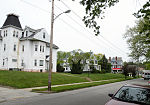Washington & Jefferson College

Washington & Jefferson College (W&J College or W&J) is a private liberal arts college in Washington, Pennsylvania. The college traces its origin to three log cabin colleges in Washington County established by three Presbyterian missionaries to the American frontier in the 1780s: John McMillan, Thaddeus Dod, and Joseph Smith. These early schools eventually grew into two competing academies, with Jefferson College located in Canonsburg and Washington College located in Washington. The two colleges merged in 1865 to form Washington & Jefferson College. The 60 acre (0.2 km2) campus has more than 40 buildings, with the oldest dating to 1793. The college's academic emphasis is on the liberal arts and the sciences, with a focus on preparing students for graduate and professional schools. Campus activities include various religious, political, and general interest clubs, as well as academic and professional-themed organizations. The college has a strong history of competing literary societies, dating back before the union of Jefferson and Washington Colleges. Students operate a college radio station, a campus newspaper, and a literary journal. The athletic program competes in NCAA Division III. A large majority of students participate in intramural athletics. Nearly all students live on campus and roughly one third are members of fraternities or sororities. A number of noteworthy alumni have attended the college or its predecessor institutions, including James G. Blaine, William Holmes McGuffey, Joseph Ruggles Wilson (the father of President Woodrow Wilson), and Pete Henry.
Excerpt from the Wikipedia article Washington & Jefferson College (License: CC BY-SA 3.0, Authors, Images).Washington & Jefferson College
East Walnut Street,
Geographical coordinates (GPS) Address External links Nearby Places Show on map
Geographical coordinates (GPS)
| Latitude | Longitude |
|---|---|
| N 40.1714 ° | E -80.2393 ° |
Address
Washington & Jefferson College
East Walnut Street
15301
Pennsylvania, United States
Open on Google Maps








